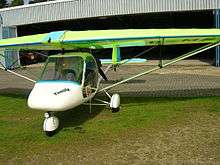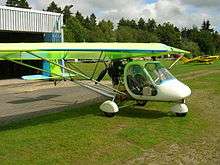Flylab Tucano
| Flylab Tucano | |
|---|---|
 | |
| Flylab Tucano V | |
| Role | Ultralight aircraft |
| National origin | Italy |
| Manufacturer | Ferrari ULM Flylab |
| Status | In production |
| Developed from | Chotia Weedhopper |
The Flylab Tucano (English: Toucan) is an Italian ultralight, produced by Flylab, of Ischitella. The aircraft is supplied as a kit for amateur construction or as a complete ready-to-fly-aircraft. The aircraft was produced in the 1990s by Ferrari ULM of Castelbaldo.[1][2]
Design and development
The Tucano is a derivative of the Chotia Weedhopper and was designed to comply with the Fédération Aéronautique Internationale microlight rules with the design goal of being a low-cost aircraft. It features a strut-braced parasol wing, a two-seats-in-side-by-side configuration enclosed or open cockpit, fixed tricycle landing gear or floats and a single engine in pusher configuration or on some models twin engines in centreline thrust arrangement.[1]
The aircraft is made from bolted-together aluminum tubing, with its flying surfaces covered in Dacron sailcloth. Its 10.17 m (33.4 ft) span wing has an area of 17 m2 (180 sq ft) and is supported by V-struts and jury struts. There is a cabane strut that passes though the windshield and cockpit area. The aircraft is built around a central bent aluminum keel tube that runs from the cockpit to the tail. Controls are standard three-axis type. Standard engines available are the 50 hp (37 kW) Rotax 503 and 64 hp (48 kW) Rotax 582 two-stroke powerplants. The fuel tank is of plastic construction, mounted under the pusher engine. The Tucano V has a glide ratio of 11:1.[1]
Variants

- Tucano
- Base model with Rotax 582 powerplant.[1][3]
- Tucano V
- Improved model, with aerodynamic clean-ups and enclosed cockpit[1][4]
- Tucano HV
- A Tucano V mounted on floats (hydro).[1][5]
- Tucano Delta3
- Open cockpit model powered by a Rotax 503[1][6]
- Tucano HD3
- Float-equipped model based on the Tucano Delta3, powered by a Rotax 503[1][7]
- Tucano HD3A
- Amphibious float-equipped model based on the Tucano HD3, powered by a Rotax 503[8]
- Tucano Delta3 TW
- Twin-engined (TW) version with Rotax 582 engines mounted in the nose and aft of the cockpit, based on the Tucano Delta3[1][9]
- Tucano Delta3 VTW
- Twin-engined version with Rotax 582 engines mounted in the nose and aft of the cockpit, with the Tucano V aerodynamic and cockpit refinements[1][10]
- Tucano X2
- Twin-engined version with Rotax 582 engines mounted in the nose and aft of the cockpit, produced in the 1990s by Ferrari ULM.[2]
Specifications (Tucano V)

Data from Bayerl and Flylab[1][4]
General characteristics
- Crew: one
- Capacity: one passenger
- Length: 6.30 m (20 ft 8 in)
- Wingspan: 10.17 m (33 ft 4 in)
- Height: 2.25 m (7 ft 5 in)
- Wing area: 16.99 m2 (182.9 sq ft)
- Empty weight: 225 kg (496 lb)
- Gross weight: 450 kg (992 lb)
- Fuel capacity: 76 litres (17 imp gal; 20 US gal)
- Powerplant: 1 × Rotax 582 twin cylinder, liquid-cooled, two stroke aircraft engine, 48 kW (64 hp)
Performance
- Maximum speed: 165 km/h (103 mph; 89 kn)
- Cruising speed: 125 km/h (78 mph; 67 kn)
- Stall speed: 52 km/h (32 mph; 28 kn)
- Never exceed speed: 170 km/h (106 mph; 92 kn)
- Maximum glide ratio: 11:1
- Rate of climb: 5.5 m/s (1,080 ft/min)
- Wing loading: 26.49 kg/m2 (5.43 lb/sq ft)
References
- 1 2 3 4 5 6 7 8 9 10 11 Bayerl, Robby; Martin Berkemeier; et al: World Directory of Leisure Aviation 2011-12, page 54. WDLA UK, Lancaster UK, 2011. ISSN 1368-485X
- 1 2 Purdy, Don: AeroCrafter - Homebuilt Aircraft Sourcebook, Fifth Edition, page 158. BAI Communications, 15 July 1998. ISBN 0-9636409-4-1
- ↑ "Tucano By Flylab". Flylab.it. Retrieved 2012-07-05.
- 1 2 "Tucano V By Flylab". Flylab.it. Retrieved 2012-07-05.
- ↑ "Tucano HV By Flylab". Flylab.it. Retrieved 2012-07-05.
- ↑ "Tucano Delta3 By Flylab". Flylab.it. Retrieved 2012-07-05.
- ↑ "Tucano HD3 By Flylab". Flylab.it. Retrieved 2012-07-05.
- ↑ "Tucano HD3A By Flylab". Flylab.it. Retrieved 2012-07-05.
- ↑ "Tucano Delta3 TW By Flylab". Flylab.it. Retrieved 2012-07-05.
- ↑ "Tucano Delta3 VTW By Flylab". Flylab.it. Retrieved 2012-07-05.
External links
| Wikimedia Commons has media related to Flylab Tucano. |